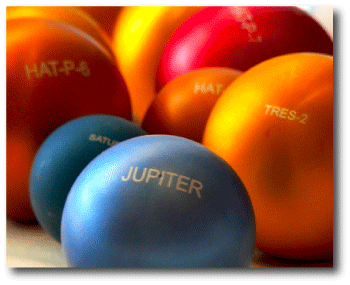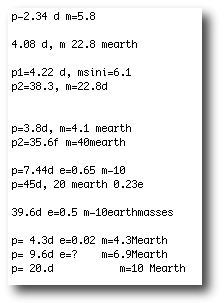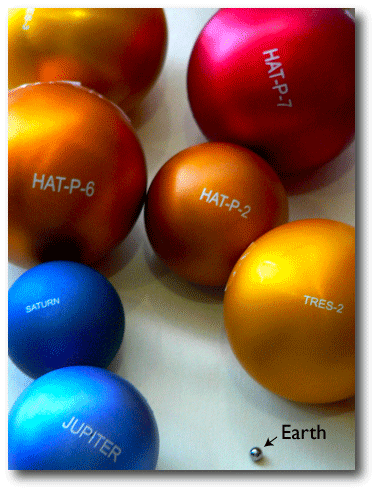
On Friday, I flew back from the Boston IAU meeting, still buzzing with excitement. On Saturday, I woke up with what might best be described as a transit-induced hangover (an entirely distinct condition from transit fever). I’d basically allowed all my professorial responsibilities to slide for a week. On my desk is a mountain of work, a preliminary exam to assemble, and a horrifying backlog of e-mail.
Ahh, but like an exotic sports car bought on credit, it was worth it. The meeting was amazing, certainly the most exciting conference that I’ve ever attended. Big ups to the organizers! Planetary transits are no longer the big deal of the future. They’re the big deal of the right here right now. Spitzer, Epoxi, MOST, HST and CoRoT are firing on all cylinders. The ground-based surveys are delivering bizarre worlds by the dozen. And we’re clearly in the midst of very rapid improvement of our understanding of the atmospheres and interiors of the planets that are being discovered.
From a long-term perspective, the conference’s biggest news was probably provided by the Geneva group, in the form of Christophe Lovis’ presentation on Tuesday afternoon. In his 15-minute talk to a packed auditorium, Lovis covered a lot of ground. I scrambled to take notes. My reconstructed summary (hopefully without major errors) runs like this:
The HARPS planet survey of solar-type stars contains ~400 non-active, slowly rotating FGK dwarfs. Observations with the 3.6-meter telescope have been ongoing since 2004, and over time, their emphasis has been progressively narrowed to focus on stars that harbor low-amplitude radial velocity variations with RMS residuals in the 0.5-2.0 m/s range. The current observing strategy is to obtain a nightly multiple-shot composite velocity of an in-play candidate during block campaigns that run for 7-10 nights.
During the first few minutes, Lovis reviewed the current status of the published results. The Mu Arae planets (including the hot Neptune on the 9.6-day orbit, see here and here) are all present and accounted for. The HD 69830 triple-Neptune data set (see here, here and here) now contains twice as many velocities, with virtually no changes to the masses and orbits of the three known planets. Long-term scatter in the HD 69830 data set is at the ~90 cm/sec level, indicating either the effect of residual stellar jitter, or perhaps the presence of additional as-yet uncharacterized bodies.
He then announced that there are currently forty-five additional candidate planets with Msin(i)<30 Earth masses, P<50 days and acceptable orbital solutions. And that’s not counting candidates orbiting red dwarfs.
He then began to highlight specific systems. To say that planets were flying thick and fast is an understatement. Here’s the verbatim text that I managed to type out while simultaneously attempting to focus on the talk:

Rumor has it that some of these systems will be officially unveiled at the upcoming Nantes meeting on Super Earths. Odds-on, with 45 candidates in play, we’ll soon be hearing about a transiting planet with a mass of order ten times Earth’s. I won’t be at the Nantes meeting, but the stands will be harboring agents of the Oklo Corporation.
The talk finished with an overview of the statistics of the warm Neptune population. Most strikingly, a full 80% of the candidates appear to belong to multiple planet systems, but cases of low-order mean motion resonance seem to be rare [as predicted –Ed.] . There is a concentration of these planets near the 10-day orbital period, and the mass function is growing toward lower masses. Significant eccentricities seem to be the rule. And finally, I think it was mentioned that the planet-metallicity correlation is weaker for the warm Neptunes than for the population of higher-mass planets.
Seems like core accretion is standing the test of time.
Note on the images: Gaspar Bakos (of HAT fame) had the cool idea of machining metal models for the planets of known radius which are correct in terms of relative size, and which have the actual density of their namesakes. HAT-P-6, for example, is constructed from a hollow aluminum shell, and with a density of ~0.6 gm/cc it would float like a boat. HAT-P-2b, on the other hand, which packs 8.6 Jupiter masses into less than a Jovian radius, has the density of lead and (not coincidently) is made out of lead. It’s startling to pick it up. CoRoT-Exo-3b, which was announced at the meeting, has a mass of twenty Jovian masses, and a radius just less than Jupiter. I guess that one will have to be made from Osmium.
Earth, at ~5.5 gm/cc, on the other hand, can be readily manufactured from a variety of different alloys.


Greg, I think you forgot some links.
“The Mu Arae planets (including the hot Neptune on the 9.6-day orbit, see here, here and here) are all present and accounted for.”
No links =(
Hi Hungry4info2,
Indeed! I’ve put in the links (two instead of three).
Also, for the record, I should point out that Osmium is a viable ingredient for a CoRoT-Exo-3b model only if the radius turns out to be larger than the reported radius at the ~2 sigma level. Otherwise, it’ll have to be finessed with some sort of servomagnet set up.
cheers,
Greg
Pingback: Blog de Astronomia do astroPT » Super-Terra à Vista !
Pingback: Centauri Dreams » Blog Archive » IAU: COROT’s Unusual Catch and More
Unsurprisingly, habitability stores are circulating around. With all of the candidates having periods less than 50 days, I don’t think habitability is a very likely aspect.